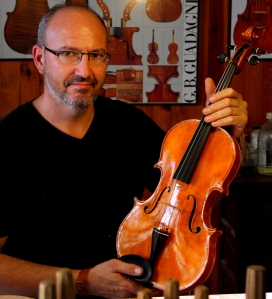es
 Roberto Cuesta nace en Madrid en 1963 en el seno de una familia de músicos. Realiza estudios musicales de violín y posteriormente de viola. Desde que tiene un instrumento en las manos se interesa por ellos, y ya en su juventud empieza a estudiar su funcionamiento y construcción. En 1990 ingresa en la Orquesta Nacional de España, y en 1993 obtiene el puesto de viola solista, cargo que desempeña hasta el año 2008. Desde ese momento se centra en su segunda gran pasión, la luthería, y comienza a desarrollar y profundizar en la construcción de instrumentos de cuerda, su historia y su evolución.
Roberto Cuesta nace en Madrid en 1963 en el seno de una familia de músicos. Realiza estudios musicales de violín y posteriormente de viola. Desde que tiene un instrumento en las manos se interesa por ellos, y ya en su juventud empieza a estudiar su funcionamiento y construcción. En 1990 ingresa en la Orquesta Nacional de España, y en 1993 obtiene el puesto de viola solista, cargo que desempeña hasta el año 2008. Desde ese momento se centra en su segunda gran pasión, la luthería, y comienza a desarrollar y profundizar en la construcción de instrumentos de cuerda, su historia y su evolución.
Comienza de la mano de Agustín Clemente, también músico y luthier especialista en luthería italiana. Este le introduce tanto en los modos de hacer clásicos, como en la actual Escuela de Luthería de Cremona.
Viaja a Italia y conoce a importantes luthieres del momento, como Massimo Negroni, profesor de la citada escuela, Robert Gasser, Carlos Roberts, o Borja Bernabeu, ganador de varios premios en Italia y Estados Unidos. Este último, al ver su trabajo, le invita a trabajar y colaborar con él en su taller, perfeccionando su estilo y mejorando en diversos aspectos. En la actualidad mantiene con ellos un contacto regular, intercambiando experiencias y colaborando profesionalmente.
us
 Roberto Cuesta was born in Madrid in 1963 to a family of profesional musicians. He begins his musical studies with the violin and later takes up the viola. Since the first time he had a musical instrument in his hands he was fascinated by them, and from a young age began to study in depth how they work and are constructed. In 1990 he becomes a member of Spanish National Orchestra, and in 1993 becomes the lead violist, position he held until 2008. Since then he focuses on his second great passion, the lutherie, and begins to delve into the construcción of string instruments, their history and evolution .
Roberto Cuesta was born in Madrid in 1963 to a family of profesional musicians. He begins his musical studies with the violin and later takes up the viola. Since the first time he had a musical instrument in his hands he was fascinated by them, and from a young age began to study in depth how they work and are constructed. In 1990 he becomes a member of Spanish National Orchestra, and in 1993 becomes the lead violist, position he held until 2008. Since then he focuses on his second great passion, the lutherie, and begins to delve into the construcción of string instruments, their history and evolution .
Taking advantage of this new situation, he began to develop in greater depth his second great passion, the construction of stringed instruments, their history and evolution, violin making.
He starts his apprenticeship with Agustín Clemente, also a musician and violin maker specializing in Italian violin making. This proves to be his introduction to how the classics were made as in the “Cremonese School of Violin Craftsmanship”.
He travels to Italy and become acquainted with the most important contemporary craftsmen such as Massimo Negroni, a teacher of the aforementioned school, Robert Gasser, Carlos Roberts, and Borja Bernabeu, winner of several prizes in Italy and USA. Borja, on seeing his work invites him to work and collaborates with him in his atelier to perfect his style and technique in some aspects. Presently he maintains a regular contact with him, exchanging experiences and working together professionally.
